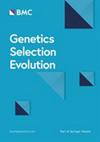Expression and structural analysis of taste receptor genes in Iberian and Duroc pigs
IF 3.1
1区 农林科学
Q1 AGRICULTURE, DAIRY & ANIMAL SCIENCE
引用次数: 0
Abstract
Taste receptor genes are expressed in sensory cells located in the tongue and influence food preferences, voluntary feed intake, and other relevant traits. Taste perception may differ between livestock breeds that show differences in eating behaviour and between animals that receive different diets or show phenotypic variation in feed intake or related-traits. The objectives of this work were to deepen the understanding of the regulation of the function of taste receptor genes in the circumvallate papillae of obese Iberian pigs in comparison to Duroc pigs, and to characterize their genetic variation and associations with relevant production traits. We performed a gene expression and structural analysis of ten taste receptor genes in Iberian and Duroc pigs. Gene expression was quantified in the circumvallate papillae of 48 growing Iberian and Duroc pigs maintained under identical management conditions but fed isocaloric diets differing in energy source: either high concentration of fat rich in oleic acid (HO) or carbohydrates (CH); and sacrificed after 47 days of treatment (50.5 kg live weight). Gene expression differed between the two breeds for most of the analyzed genes, with the TAS1R1, TAS1R2, TAS1R3, TAS2R4, TAS2R38, TAS2R39, GPR84, and CD36 genes being overexpressed in Duroc pigs. The diet effect was modulated by breed, with TAS1R1, TAS1R3, and TAS2R4 genes being overexpressed only in Duroc pigs fed the HO diet. Detection of genetic variants (single nucleotide polymorphisms, SNPs) for this panel of genes was performed on muscle RNA-seq data, and three SNPs in the TAS1R1, TAS1R3, and CD36 genes were selected for association studies. All three SNPs were associated with various growth, fattening, tissue fat content, and composition traits. Moreover, the CD36:c.910G/T SNP was associated with oral CD36 gene expression and with differences in the predicted mRNA secondary structure. Most taste receptor genes are expressed at lower level in circumvallate papillae from Iberian than Duroc pigs. This aligns with lower overall taste sensitivity, higher feed intake, and obese nature of Iberian pigs. Significant association results were observed for SNPs in the TAS1R1 and TAS1R3 genes with meat quality traits and liver composition, which showed segregation in world-wide distributed breeds, but particularly for a potential causal SNP in the CD36 gene, associated with growth and tissue composition, which segregates in Iberian populations.伊比利亚猪和杜洛克猪味觉受体基因的表达及结构分析
味觉受体基因在舌头的感觉细胞中表达,影响食物偏好、自愿采食量和其他相关特征。味觉感知可能在表现出饮食行为差异的牲畜品种之间,以及在接受不同饮食或在采食量或相关性状方面表现出表型差异的动物之间有所不同。这项工作的目的是加深对肥胖伊比利亚猪与杜洛克猪的味觉受体基因在环状乳头中的功能调控的理解,并表征其遗传变异及其与相关生产性状的关联。我们对伊比利亚猪和杜洛克猪的十个味觉受体基因进行了基因表达和结构分析。在相同的管理条件下饲养48头伊比利亚和杜洛克生长猪,饲喂不同能量来源的等热量饲粮:高浓度富含油酸(HO)或碳水化合物(CH)的脂肪;治疗47 d后处死(活重50.5 kg)。所分析的大多数基因在两个品种之间的表达存在差异,杜洛克猪中TAS1R1、TAS1R2、TAS1R3、TAS2R4、TAS2R38、TAS2R39、GPR84和CD36基因过表达。饲粮效应受品种调节,TAS1R1、TAS1R3和TAS2R4基因仅在饲喂HO饲粮的杜洛克猪中过表达。在肌肉RNA-seq数据上检测这组基因的遗传变异(单核苷酸多态性,SNPs),并选择TAS1R1、TAS1R3和CD36基因中的三个SNPs进行关联研究。所有三个snp都与各种生长、增肥、组织脂肪含量和组成性状有关。此外,CD36:c。910G/T SNP与口腔CD36基因表达和预测mRNA二级结构的差异有关。大多数味觉受体基因在伊比利亚猪环戊瓣乳突中的表达水平低于杜洛克猪。这与伊比利亚猪的整体味觉敏感度较低、采食量较高和肥胖性质相一致。TAS1R1和TAS1R3基因的SNP与肉质性状和肝脏组成显著相关,这表明在世界范围内分布的品种中存在分离,但特别是与生长和组织组成相关的CD36基因的潜在因果SNP,在伊比利亚种群中存在分离。
本文章由计算机程序翻译,如有差异,请以英文原文为准。
求助全文
约1分钟内获得全文
求助全文
来源期刊

Genetics Selection Evolution
生物-奶制品与动物科学
CiteScore
6.50
自引率
9.80%
发文量
74
审稿时长
1 months
期刊介绍:
Genetics Selection Evolution invites basic, applied and methodological content that will aid the current understanding and the utilization of genetic variability in domestic animal species. Although the focus is on domestic animal species, research on other species is invited if it contributes to the understanding of the use of genetic variability in domestic animals. Genetics Selection Evolution publishes results from all levels of study, from the gene to the quantitative trait, from the individual to the population, the breed or the species. Contributions concerning both the biological approach, from molecular genetics to quantitative genetics, as well as the mathematical approach, from population genetics to statistics, are welcome. Specific areas of interest include but are not limited to: gene and QTL identification, mapping and characterization, analysis of new phenotypes, high-throughput SNP data analysis, functional genomics, cytogenetics, genetic diversity of populations and breeds, genetic evaluation, applied and experimental selection, genomic selection, selection efficiency, and statistical methodology for the genetic analysis of phenotypes with quantitative and mixed inheritance.
 求助内容:
求助内容: 应助结果提醒方式:
应助结果提醒方式:


